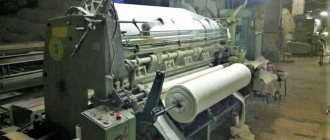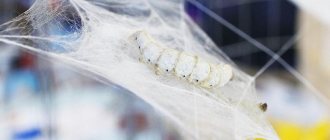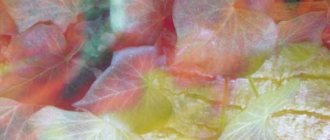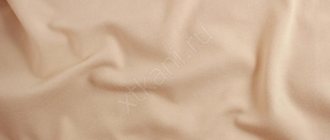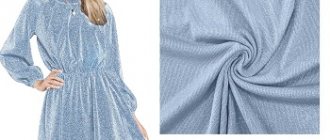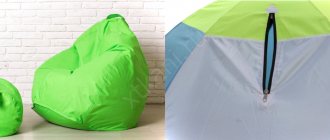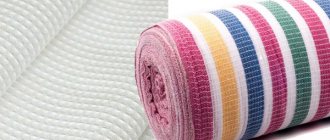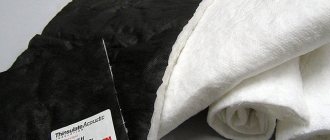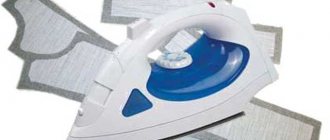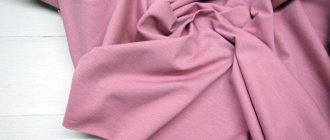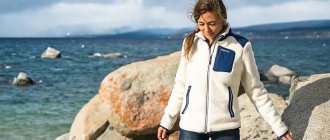Types of nonwoven materials
Nonwoven materials are products prepared from chemical fibers. There are several types of non-woven coverings available for sale, differing in technical parameters and properties. Similar results were achieved using a variety of manufacturing techniques. To make it easier to decide, it is worth familiarizing yourself with the main types.
Spunbond
The preparation of such material is carried out by pressing pre-prepared raw materials through special dies, the diameter of which is relatively small. Only after this the fibers are thoroughly cooled, drawn out, and laid on a flat surface. In order to connect the prepared and cooled fibers, a calender is used.
The fabric prepared in this way is distinguished by its increased level of density, wear resistance, and strength. This material is waterproof, easy to store and use. It is quite often used in the process of preparing non-sterile products.
Spunlace
The preparation of this nonwoven material is carried out practically according to the same principle as spunbond. The only difference is that the fibers are intertwined using water jets that are supplied under high pressure. This type of non-woven material is made from polypropylene, viscose, and polyester fibers. In some cases, several types of fibers are combined. As a rule, several types of fibers are combined if it is necessary to enhance certain properties of the fabric.
This type of nonwoven material has the following advantages:
- Excellent tactile comfort.
- The coating does not interfere with free air circulation.
- The durability of the coating is quite high.
- The material has excellent protective properties.
- The elasticity coefficient of the coating is quite low.
This type of non-woven material should not be used in excessively humid climates, since it absorbs moisture well, and its weight increases.
Application area
Non-woven fabrics are widely used in everyday life and in many industries. Each of us is surrounded by objects made partially or completely from non-woven materials. Examples of their application:
- Hygiene products. Disposable diapers, feminine absorbent sanitary pads, beauty wipes, and furniture polishing wipes are made from polyester, polypropylene, or cellulose fibers. The delicate structure of the material obtained from them is ideal for contact with skin or delicate surfaces of interior items.
- Medicine. Disposable diapers, medical masks, surgical drapes and dressings have two significant advantages over their predecessors, which were made from cloth or gauze. When using such materials, there is no risk that the thread separated from the fabric will get into the wound and cause inflammation. In addition, used disposable items made from new material are easier to dispose of without harming the environment.
- Geotextiles. Special canvases help isolate cultivated plants from weeds, which is why gardeners and gardeners often use them. Seeds are germinated in pots and bowls made of non-woven materials and seedlings are propagated. When laying tiles on roads, a protective layer of geotextile is placed underneath it, which prevents the germination of weeds and grass and makes the coating more durable and stable.
- Insulation materials. Lining made of batting or more modern padding polyester is used in the manufacture of clothing and footwear for the cold season, as well as thermal underwear, which has become popular in recent years. The thermal insulating layer can be found in the body of refrigerators and refrigerators. Glass wool and similar materials protect water pipes and house walls from freezing.
- Interior of premises. Comfortable fabric is used to make rugs, sofa upholstery, furniture covers, etc.
- Soundproofing. A special layer is placed around sources of loud sounds, such as centrifuges in washing machines. A protective sheet placed in the thickness of walls and doors reduces their noise permeability.
Composition of nonwoven materials
Currently, nonwoven materials are prepared from:
- Natural fibers: wool, cotton, linen.
- Chemical fibers: polyamide, viscose, polypropylene, polyester, others.
- Secondary raw materials obtained from waste from chemical and other industries.
In order to ensure reliable connection of fibers, manufacturers quite often use lavsan, glass, nylon or metal threads.
Before raw materials go into production, they must be prepared. Preparation processes are determined depending on what kind of raw materials and what manufacturing technique is used.
NON-WOVEN COATS
Agul technical minds
Official publication
G osstandart Minsk
UDC 677.076.4(083.74)(476) MKS 59.080.30 KP 03
Key words: non-woven fabrics, technical requirements, control methods, packaging, labeling
OKP RB 17.53.10.500
Preface
The goals, basic principles, provisions for state regulation and management in the field of technical regulation and standardization are established by the Law of the Republic of Belarus “On technical regulation and standardization.”
1 DEVELOPED by the national technical committee for standardization TC 12 “Light Industry” (secretariat of the RUE “Center for Scientific Research of Light Industry”)
INTRODUCED by the Belarusian State Concern for the Production and Sales of Light Industry Goods
2 APPROVED AND ENTERED INTO EFFECT by Resolution of the State Standard of the Republic of Belarus dated May 30, 2011 No. 25
3 INTRODUCED FOR THE FIRST TIME
4 RE-ISSUE (October 2013) with CHANGE No. 1, approved in April 2013 (IUTNPA No. 4-2013)
© Gosstandart, 2013
This standard cannot be reproduced, replicated or distributed as an official publication without the permission of the State Standard of the Republic of Belarus
Published in Russian
STATE STANDARD OF THE REPUBLIC OF BELARUS
NONWOVEN FABRICS General technical specifications
NAT-WOVEN COATS Agulny technical washings
Textile sheets General specifications
Date of introduction 2012-01-01
1 area of use
This standard applies to canvas-stitched, knit-stitched, thread-stitched, fabric-stitched and needle-punched non-woven fabrics (hereinafter referred to as fabrics) intended for use as insulating lining in garments, for the manufacture of shoe parts, for use as cushioning material in the manufacture of upholstered furniture and other purposes.
2 Normative references
This standard uses references to the following technical regulatory legal acts in the field of technical regulation and standardization (hereinafter referred to as TYPE):
TR CU 017/2011 On the safety of light industry products
STB ISO 105-С10-2009 Textile materials. Determination of color fastness. Part of SY. Method for determining color fastness to washing with soap or soap and soda
STB ISO 105-E04-2010 Textile materials. Determination of color fastness. Part E04. Method for determining color fastness to sweat
STB ISO 105-Х12-2009 Textile materials. Determination of color fastness. Part XI2. Method for determining color fastness to friction
STB 1400-2009 Non-food products. Information for the consumer. General requirements STB ISO 3758-2011 Textile products. Marking with care symbols GOST 12.1.005-88 System of occupational safety standards. General sanitary and hygienic requirements for the air in the working area
GOST ISO 1833-2001 Textile materials. Methods for quantitative chemical analysis of two-component fiber mixtures
GOST 3811-72 (ISO 3801-77, ISO 3932-76, ISO 3933-76) Textile materials. Fabrics, non-woven fabrics and piece goods. Methods for determining linear dimensions, linear and surface densities
GOST 3816-81 (ISO 811-81) Textile fabrics. Methods for determining hygroscopic and water-repellent properties
GOST 4659-79 Pure wool and half-woolen fabrics and yarn. Chemical test methods GOST ISO 5088-2001 Textile materials. Methods for quantitative analysis of three-component fiber mixtures
GOST 6904-83 Heavy twisted cotton yarn for weaving. Specifications
GOST 7000-80 Textile materials. Packaging, labeling, transportation and storage GOST 9092-81 Cotton yarn for knitting production. Technical specifications GOST 9733.4-83 Textile materials. Test method for color fastness to washing GOST 9733.6-83 Textile materials. Test methods for color fastness to “sweat”
GOST 9733.27-83 Textile materials. Test method for color fastness to friction GOST 11109-90 Household cotton gauze. General technical conditions GOST 13587-77 Non-woven fabrics and piece non-woven products. Acceptance rules and sampling method
Official publication
GOST 13827-85 Non-woven fabrics. Primary packaging and marking GOST 14192-96 Marking of cargo
GOST 15902.2-2003 (ISO 9073-2:1995) Non-woven fabrics. Methods for determining structural characteristics
GOST 16919-79 Non-woven textile fabrics. Norms of permissible deviations in terms of physical and mechanical properties
GOST 30084-93 Textile materials. Primary marking
Note - When using this standard, it is advisable to check the validity of the TYPE against the catalog compiled as of January 1 of the current year and against the corresponding information indexes published in the current year.
If reference TYPES are replaced (changed), then when using this standard you should be guided by the replaced (changed) TYPES. If reference TYPES are canceled without replacement, then the provision in which a reference to them is given applies to the extent that does not affect this reference.
Section 2 (Changed edition, Amendment No. 1)
Properties of nonwoven materials
Nonwoven materials have a number of unique properties:
- Uniformity of structure. Due to the fact that the fibers used in production are connected as firmly as possible and are distributed evenly, the load on the material is distributed evenly along the entire perimeter. This eliminates the possibility of deformation, excessive tension of the coating, or violation of its integrity.
- Density. Since nonwoven materials have a higher level of density, they can be used to minimize the evaporation of moisture from the ground. As a result, watering rates will also be reduced.
- The material helps maintain an optimal temperature level, due to which the soil warms up much faster.
- High level of strength. Neither mechanical load nor chemical components affect the basic properties of the nonwoven material. Therefore, it can be used in the most severe conditions.
- Long period of use. Most types of non-woven fabric can be used for 10 years or more. Manufacturers managed to achieve similar results by connecting different types of fibers and combining them. Do not forget that the service life is influenced by both correct installation and compliance with storage conditions.
- Ease of use. The instructions supplied by the manufacturers contain detailed information regarding installation rules. By following them, you can implement everything quite quickly.
- All products undergo a certification process.
Differences
Canvas-stitched non-woven fabric differs in several parameters. Any manufacturer must adhere to GOST 14253-83. Among the characteristics, the most important are the following.
- The length of the stitch holding the material together. It can be 2.5 mm, 5 mm or 10 mm. The shorter the tie, the stronger and more durable the product.
- Density. Usually this value is 170-200 g/m2 (sometimes 350 g/m2). The strength of a product is also proportional to its density. Density also affects the weight of the material.
- The width of the canvas can be very different - from 54 to 180 cm.
